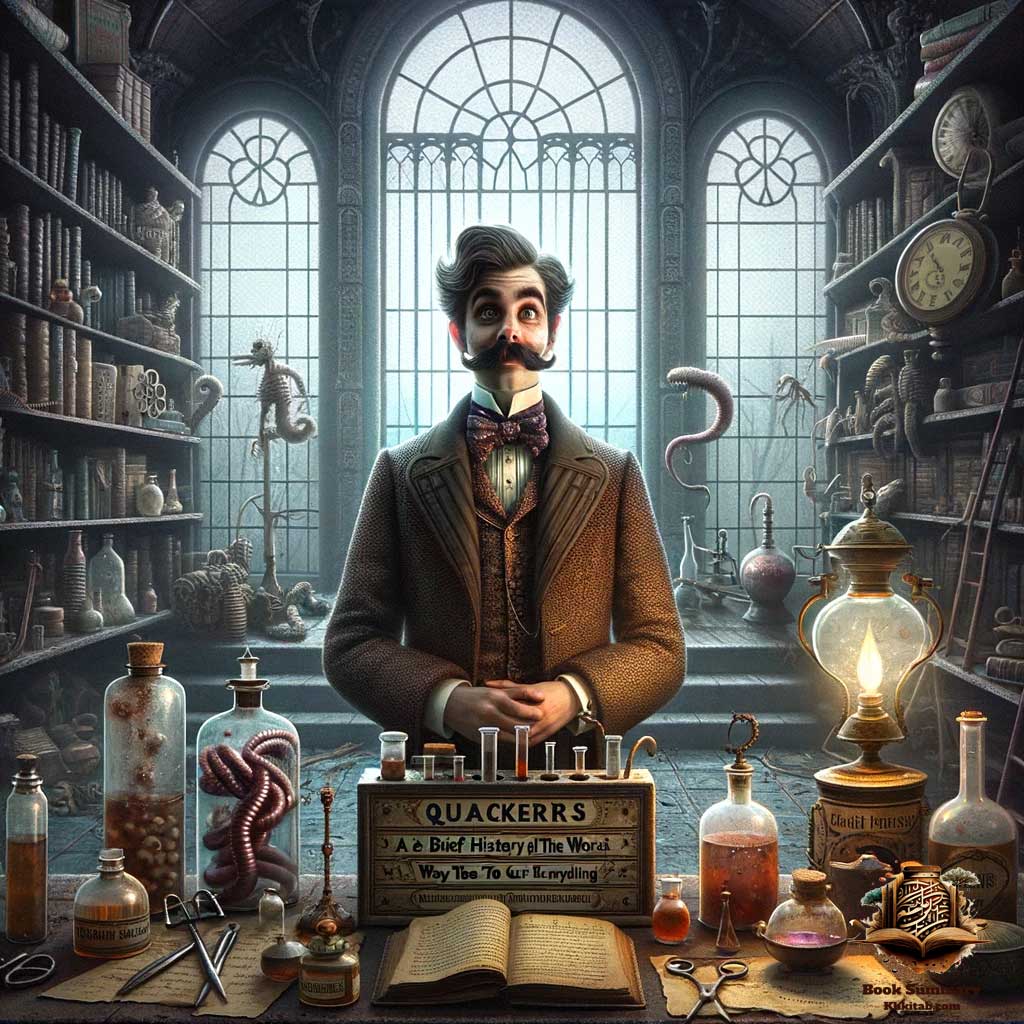Quackery: A Brief History of the Worst Ways to Cure Everything Book Summary

“Quackery: A Brief History of the Worst Ways to Cure Everything” is a fascinating journey into the annals of medical history, spotlighting some of the most bizarre, dangerous, and absurd treatment methods that have been used throughout time. Authored by Lydia Kang, a physician and writer, and Nate Pedersen, a researcher and writer, this book presents a rich and detailed view of the various methods used in attempts to heal, ranging from the peculiar to the perilous to the downright ludicrous.
The book takes readers on a journey through time, starting from ancient ages, through the medieval period, and into the modern era, illustrating how treatment attempts reflected human understanding and beliefs in each era. “Quackery” reveals how humans have dealt with diseases and ailments in ways that may seem strange and even terrifying to us today, from using poisons like mercury and lead in treatments to believing in the powers of magic and sorcery.
What sets this book apart is its smooth and engaging style that turns medical history into a compelling subject for both general readers and specialists alike. Using clear language and vivid examples, the book makes it easy for readers to understand how healing practices have evolved and how they were influenced by cultural and popular beliefs across different periods.
إقرأ أيضا:This Is Marketing: A New Perspective on Brands and SalesMoreover, “Quackery” offers deep reflections on topics such as safety and efficacy in medicine, and how trust in medical practices is formed. It highlights the importance of critical and scientific thinking in the face of dubious treatments, showing how some ideas that were once considered acceptable are now dismissed thanks to advances in medical science.
In conclusion, “Quackery: A Brief History of the Worst Ways to Cure Everything” provides an insightful and enjoyable look at the history of medicine, shining a light on the mistakes and experiments that have shaped the course of this vital science. It is an informative and entertaining book, making it a valuable addition for anyone interested in the history and evolution of medicine.
How Does ‘Quackery’ Illuminate the Evolution of Medicine Through History?
In “Quackery: A Brief History of the Worst Ways to Cure Everything,” the historical background of medicine is not just a topic; it’s a vivid journey through the ages, illustrating the fascinating evolution of medical practices from ancient times to the contemporary era. This book offers readers an exceptional glimpse into how medical understanding and practices have drastically transformed over the centuries.
From Ancient Remedies to Modern Medicine: A Comprehensive Overview
The book begins by taking us back to the roots of early medicine, where treatments were deeply intertwined with cultural beliefs and superstitions. In ancient times, medical practices were often a blend of ritual, religion, and early attempts at science. This period was marked by a lack of understanding of human anatomy and disease, leading to the use of practices that may seem archaic by today’s standards. For instance, the use of herbs and plants, while sometimes effective, was largely based on trial and error, with a significant influence of myth and lore.
As we move forward in time, the book highlights how the Greek and Roman civilizations began to lay the foundations for a more systematic approach to medicine. This era saw the rise of influential figures like Hippocrates and Galen, who started to separate medicine from philosophy and superstition, although their understanding of diseases and treatments was still primitive compared to modern knowledge.
The Middle Ages and the Renaissance period brought their own sets of challenges and advancements. During these times, the book reveals how plagues and epidemics prompted a desperate search for cures, often leading to the use of bizarre and dangerous treatments. It was a time of alchemy and astrology, where illness was sometimes seen as a result of celestial influences or moral failings.
The journey then transitions into the modern era, where the book illustrates a significant shift with the advent of the scientific method and evidence-based medicine. This period witnessed groundbreaking discoveries like the germ theory of disease and the development of vaccines, which revolutionized the approach to treatment and prevention of illnesses. The authors highlight how these advancements led to a dramatic improvement in life expectancy and quality of life.
Throughout this historical exploration, “Quackery” maintains a focus on the dichotomy between traditional beliefs and emerging scientific understanding. It portrays the gradual, often challenging shift from a world riddled with medical superstitions and dangerous practices to one where science began to lead the way in healthcare. The book serves as a reminder of how far we have come in understanding and treating human diseases, and how this journey has been a complex blend of cultural, social, and scientific factors.
By offering a comprehensive overview of the historical background of medicine, “Quackery” not only educates but also enthralls readers, inviting them to appreciate the complexity and the strides made in the field of medicine. It’s a testament to human endeavor, curiosity, and the relentless pursuit of better health care practices, making it a must-read for anyone fascinated by the history and evolution of medicine.
The Art of War: Strategies and Tactics that Shaped the Course of Battles Throughout History
How Did Ancient and Medieval Treatments Shape Early Medicine According to ‘Quackery’?
In “Quackery: A Brief History of the Worst Ways to Cure Everything,” the exploration of ancient and medieval treatments provides a compelling insight into the early foundations of medical practice. This section of the book not only captures the reader’s imagination with its vivid descriptions of bizarre and often dangerous treatments but also offers a deeper understanding of how these practices shaped early medicine.
Delving into the World of Ancient Medical Practices
The book takes readers on a fascinating journey back to a time when medical knowledge was limited, and treatments were largely based on superstition and guesswork. One of the most striking examples discussed is bloodletting, a practice rooted in the ancient belief in balancing bodily humors. According to the authors, Lydia Kang and Nate Pedersen, bloodletting was not just a simple procedure; it was an art form, with practitioners believing that releasing blood could cure a plethora of ailments, from fevers to headaches to mental illnesses.
Another intriguing aspect covered in “Quackery” is the use of leeches, which were often employed in tandem with bloodletting. The book details how leeches were a popular remedy for removing ‘bad blood’ and were believed to be effective in treating everything from skin diseases to nervous system disorders. The authors provide engaging anecdotes about the widespread use of leeches, highlighting how this practice persisted well into the 19th century, despite the risks and often dubious results.
Medieval Medicine: A Blend of Tradition and Myth
As the book moves into the medieval era, it illustrates how medicine began to evolve yet remained deeply entrenched in traditional beliefs and myths. The authors discuss how the church and superstition played significant roles in medical treatments during this period. One notable example is the use of relics and prayers as a form of healing, where the faithful believed that divine intervention could cure their ailments.
The medieval section of “Quackery” also delves into the alchemy’s influence on medicine. Alchemists, in their quest to transform base metals into gold, inadvertently contributed to the development of pharmacology. The book recounts tales of alchemists experimenting with various substances, some of which led to discoveries of medicinal properties, while others proved to be fatal.
Reflections on the Impact of Early Treatments
Throughout these chapters, “Quackery” not only recounts these historical practices but also reflects on their impact. The authors argue that, despite their apparent primitiveness, these early treatments laid the groundwork for the development of modern medicine. They emphasize that understanding these ancient and medieval practices provides valuable insights into the evolution of medical thought and the gradual shift towards more empirical methods.
In summary, “Quackery: A Brief History of the Worst Ways to Cure Everything” offers an in-depth and engaging exploration of ancient and medieval treatments, highlighting their significance in the broader context of medical history. This section of the book is particularly effective in showcasing how early medical practices, although often misguided, were crucial steps in humanity’s ongoing quest to understand and heal the human body. It’s a compelling read for anyone interested in the origins of medical practices and how they have shaped the development of modern healthcare.
Our Facebook Page – Book Summary
How Did ‘Quackery’ Explore the Historical Use of Toxins and Heavy Metals in Medicine?
In “Quackery: A Brief History of the Worst Ways to Cure Everything,” a significant portion of the narrative delves into the historical use of toxins and heavy metals in medical treatments. This aspect of the book is particularly fascinating as it sheds light on the paradoxical practice of using substances like mercury, lead, and arsenic, which were once believed to possess healing properties. Through detailed accounts and intriguing stories, the authors, Lydia Kang and Nate Pedersen, unravel how these dangerous substances became integral parts of medical practices.
Mercury: A Double-Edged Sword in Medicine
One of the most compelling discussions in “Quackery” revolves around mercury, a substance renowned for its healing and destructive properties. The book takes readers through various historical periods where mercury was used as a cure-all for a multitude of diseases, most notably syphilis. The authors provide vivid descriptions of treatments, including the use of mercury ointments and pills, highlighting not only their widespread popularity but also the severe side effects, such as tooth loss, neurological damage, and even death.
Lead: The Ancient Remedy with Lethal Consequences
The use of lead in medicine is another intriguing aspect covered in “Quackery.” The book details how lead, known for its malleability and easy availability, was incorporated into various treatments in ancient times. The authors narrate how lead compounds were used in ointments and potions, believed to treat conditions like gout and even infertility. However, they also critically examine the darker side of lead use, illustrating how its toxicity led to numerous health problems, often exacerbating the ailments it was meant to cure.
Arsenic: A Poison and a Panacea
Arsenic’s dual role as a poison and a medicinal remedy is thoroughly explored in the book. The authors describe how arsenic, despite its known lethal qualities, was hailed as a miracle cure for a range of illnesses, including cancer and skin conditions. “Quackery” provides detailed accounts of how arsenic found its way into mainstream medicine, often being prescribed in small doses with the belief that it could rejuvenate health. The narrative is rich with historical anecdotes that underscore the dangerous gamble of using such a potent toxin in medicine.
Reflecting on the Paradox of Toxic Treatments
Throughout these sections, “Quackery” not only recounts the historical use of these toxic substances but also reflects on the broader implications of such practices. The authors discuss how the lack of scientific understanding and the desperation for cures led to the widespread adoption of these hazardous treatments. They emphasize that the history of using toxins and heavy metals in medicine serves as a cautionary tale, highlighting the importance of scientific rigor and safety in medical practices.
In summary, “Quackery: A Brief History of the Worst Ways to Cure Everything” offers an insightful exploration into the historical use of toxins and heavy metals in medicine. By presenting detailed stories and critical analyses, the book invites readers to understand the complexities and dangers inherent in these ancient practices, contributing significantly to the conversation on the evolution of medical science and the lessons learned from its past.
How Did Superstition and Magic Influence Medical Practices as Explored in ‘Quackery’?
In “Quackery: A Brief History of the Worst Ways to Cure Everything,” the authors delve into the fascinating realm of how superstition and magic played pivotal roles in shaping medical practices throughout history. This aspect of the book offers a profound understanding of how these beliefs, often deeply rooted in cultural and societal norms, significantly impacted patient care.
The Deep-Rooted Influence of Superstition in Medicine
The book begins by exploring the ancient and medieval world, where medicine and superstition were often indistinguishably intertwined. In these times, illnesses were frequently attributed to supernatural causes such as curses or displeasure of the gods. The authors, Lydia Kang and Nate Pedersen, bring to life various examples where superstitions dictated the course of treatments. For instance, they recount how certain ailments were believed to be cured by rituals or amulets, with patients placing their faith in mystical solutions rather than medical expertise.
Magic as a Tool for Healing
“Quackery” also delves into the use of magic as a tool for healing. The book illustrates how, in the absence of scientific understanding, magic filled the void for explaining the unexplainable. Healers, often revered as wise and powerful, would use spells, charms, and incantations, believed to have the power to cure or alleviate various conditions. The authors describe how these practices were not just mere rituals; they were integral to the healthcare system of those times, reflecting the human need to find hope and healing in the face of illness.
The Transition from Superstition to Science
One of the most intriguing aspects of this section of the book is how it traces the transition from superstition-based treatments to more scientific approaches. The authors discuss the Renaissance period, a time of significant change, where the gradual increase in scientific knowledge began to challenge and replace many of the superstitious beliefs. However, they also note that this transition was not immediate or complete, as many superstitions continued to linger and influence medical practices.
The Lasting Impact of Superstition and Magic on Medicine
Throughout the book, the authors reflect on the lasting impact of superstition and magic on medicine. They emphasize that understanding this history is crucial for comprehending the evolution of medical thought and practice. The narrative is peppered with engaging stories and anecdotes that not only entertain but also provide valuable insights into how these ancient beliefs and practices have shaped, and in some ways continue to influence, modern medicine.
In conclusion, “Quackery: A Brief History of the Worst Ways to Cure Everything” offers an in-depth and engaging exploration of the role of superstition and magic in medical history. By presenting a balanced view of these practices, the book invites readers to appreciate the complex and often misunderstood relationship between medicine, superstition, and magic, highlighting the continuous evolution of medical science from its mystical roots to its current evidence-based approach.
How Did Patent Medicines and Quackery Shape Medical History as Described in ‘Quackery’?
In “Quackery: A Brief History of the Worst Ways to Cure Everything,” the authors provide a comprehensive look into the emergence and popularity of patent medicines, a pivotal aspect of medical history that intertwines with the phenomenon of quackery. This section of the book reveals how these so-called remedies, often laced with addictive or harmful ingredients, played a significant role in shaping public perception and practice of medicine.
The Rise of Patent Medicines
The book details the rise of patent medicines in the 18th and 19th centuries, particularly in the United States and Europe. These were often over-the-counter concoctions marketed aggressively as cure-alls for a wide range of ailments. Lydia Kang and Nate Pedersen, the authors, paint a vivid picture of this era, where lax regulations allowed for the widespread sale of these medicines without any proof of efficacy or safety. They describe how these medicines became a cultural phenomenon, with colorful labels and grandiose claims, capturing the imagination and trust of the general public.
Addictive Ingredients and Misleading Claims
One of the most striking aspects discussed in “Quackery” is the composition of these patent medicines. The authors delve into how many of these concoctions contained addictive substances like opium, alcohol, cocaine, and morphine, often unbeknownst to the consumers. They present stories and examples of popular patent medicines of the time, illustrating how these addictive ingredients led to widespread dependency issues among users, all under the guise of treatment.
Impact on Public Health and Regulation
The book also examines the impact of patent medicines and quackery on public health and the eventual push for regulation. It highlights how the unregulated market led to numerous health problems and even fatalities, spurring a public outcry that eventually led to legislation like the Pure Food and Drug Act in the United States. This act, as discussed in the book, was a turning point in medical history, marking the beginning of regulated pharmaceuticals.
Reflections on the Role of Quackery in Medicine
Throughout this section, “Quackery” offers reflections on the role of quackery in medicine. The authors discuss how the phenomenon of patent medicines mirrored the desperation and hope of the public for cures, as well as the exploitation of this desperation by opportunists. They emphasize that understanding the history of patent medicines and quackery is crucial for comprehending the evolution of medical ethics, consumer protection, and the importance of evidence-based medicine.
In conclusion, “Quackery: A Brief History of the Worst Ways to Cure Everything” provides an enlightening exploration of the role of patent medicines and quackery in medical history. This part of the book not only educates about a significant period in the development of modern medicine but also offers a critical reflection on how public perception, regulation, and ethical practices in medicine have been shaped by the challenges and experiences of the past. It’s a compelling read for anyone interested in understanding the complexities and historical transformations of the medical field.
What Role Did Pseudoscientific Treatments Play in Medical History as Explored in ‘Quackery’?
In “Quackery: A Brief History of the Worst Ways to Cure Everything,” the authors delve into the intriguing world of pseudoscientific treatments and practices that have gained popularity throughout history despite lacking scientific validity. This aspect of the book illuminates the ways in which these unproven methods have not only captivated but also misled the public and medical professionals alike.
The Allure of Pseudoscience in Medicine
The book begins by exploring how, throughout history, pseudoscientific treatments have often filled the gaps in medical understanding. In an era when scientific knowledge was limited, these treatments provided hope and answers, even if they were unfounded. Lydia Kang and Nate Pedersen, the authors, describe how various cultures and societies have been drawn to such practices, from the use of magnetic therapy to phrenology, the study of skull shapes to determine personality traits.
Popular Pseudoscientific Treatments
“Quackery” details several specific pseudoscientific treatments that gained significant popularity. One notable example is the use of radium water, which was believed to have healing properties and was widely consumed until its detrimental health effects, such as cancer and death, became evident. The book also discusses the rise of homeopathy, a practice based on the principle that “like cures like” and the use of highly diluted substances, which remains controversial due to its lack of scientific backing.
Impact on Public Perception and Health
An important theme in the book is the impact of these pseudoscientific treatments on public perception and health. The authors discuss how the desperate need for cures and relief from ailments led many to embrace these unproven methods, often resulting in wasted resources, deteriorated health, or even death. They highlight the dangers of embracing treatments without scientific evidence and the importance of critical thinking and skepticism in healthcare.
The Role of Media and Marketing
“Quackery” also addresses the role of media and marketing in popularizing pseudoscientific treatments. The book illustrates how sensational advertising and compelling testimonials played a crucial role in the widespread acceptance of these treatments. It reveals the power of persuasive marketing in influencing public opinion and the sale of these dubious products.
Lessons Learned from the Past
Throughout the book, the authors reflect on the lessons that can be learned from the history of pseudoscientific treatments. They emphasize the need for scientific literacy and evidence-based medicine in modern healthcare and warn against the ongoing allure of pseudoscientific treatments that continue to find new forms in the contemporary world.
In summary, “Quackery: A Brief History of the Worst Ways to Cure Everything” offers a comprehensive and thought-provoking exploration of pseudoscientific treatments in medical history. By presenting detailed accounts and analysis of these practices, the book encourages readers to understand the complexities of medical history and the continuous need for scientific validation in the pursuit of effective healthcare solutions.
How Did Charlatans and Quacks Influence Medical History as Described in ‘Quackery’?
In “Quackery: A Brief History of the Worst Ways to Cure Everything,” the authors delve into the significant impact of charlatans and quacks on medical history. This part of the book provides an in-depth analysis of how these individuals exploited the general public’s lack of medical knowledge, often with grave consequences.
The Rise of Medical Charlatans
The book outlines the historical context that allowed charlatans to thrive. In times when medical science was not as advanced and public knowledge about health was limited, charlatans found fertile ground. They often presented themselves as skilled healers, exploiting the desperation of people suffering from various ailments. Lydia Kang and Nate Pedersen, the authors, describe how these charlatans would travel from town to town, offering miraculous cures and remedies for diseases that were often incurable at the time.
Tactics Used by Quacks
“Quackery” details the various tactics used by these fraudsters to gain the trust and money of their victims. One common strategy was the use of elaborate shows and demonstrations, which created an aura of legitimacy. The book recounts stories of charlatans who used magic tricks, dramatic storytelling, and fake testimonials to convince people of their healing powers. These performances were not only persuasive but also highly entertaining, making it easier to attract large crowds and sell their remedies.
The Role of Pseudoscience
An important aspect that the book highlights is the use of pseudoscience by charlatans and quacks. They often employed scientific-sounding terms and concepts to make their treatments appear credible. This misuse of scientific language, combined with the public’s limited understanding of science, made it easier for quacks to sell their ineffective and sometimes dangerous remedies.
Impact on Public Health
The authors discuss the impact of charlatans and quacks on public health, noting that many of their treatments were not only ineffective but also harmful. They provide examples of remedies that contained toxic substances, leading to adverse health effects and even fatalities. The book emphasizes how the actions of these charlatans not only exploited individuals but also hindered the progress of genuine medical science.
Legislation and Public Awareness
“Quackery” also explores how the activities of charlatans and quacks eventually led to increased public awareness and the implementation of legislation to regulate medical practice. The authors describe the gradual shift in public perception, from unquestioning acceptance of these charlatans to skepticism and demand for evidence-based medicine. This change played a crucial role in the development of medical regulations and standards that protect patients today.
In conclusion, “Quackery: A Brief History of the Worst Ways to Cure Everything” offers a compelling insight into the role of charlatans and quacks in shaping medical history. By detailing their tactics, impact, and the eventual push for regulation, the book sheds light on an often-overlooked aspect of medical history and underscores the importance of scientific literacy and skepticism in healthcare.
How Did Regulation and Standardization in Medicine Evolve as a Response to Quackery, According to the Book ‘Quackery’?
In “Quackery: A Brief History of the Worst Ways to Cure Everything,” a significant focus is placed on the development of regulations and standardization in the medical field. This evolution, as explored in the book, emerged as a direct response to the rampant quackery and unregulated practices that prevailed in earlier times.
The Era of Unregulated Medicine
The book begins by painting a vivid picture of an era when medical practice was largely unregulated. This lack of regulation allowed quacks and charlatans to thrive, selling dubious and often dangerous treatments to an unsuspecting public. Lydia Kang and Nate Pedersen, the authors, detail how this period was marked by a plethora of so-called remedies and treatments that lacked any scientific basis or proven efficacy.
Public Outcry and the Push for Change
As the book progresses, it describes how the harmful consequences of these unregulated practices eventually led to a public outcry. This outcry was not just from victims of quackery but also from reputable medical professionals who were concerned about the safety and credibility of medical practice. The authors highlight key historical moments and figures who played pivotal roles in advocating for change and reform in the medical field.
The Birth of Medical Regulations
“Quackery” details the gradual implementation of laws and regulations designed to protect the public from harmful medical practices. One of the landmarks in this journey was the establishment of standards for medical education and licensing, ensuring that only qualified individuals could practice medicine. The book also discusses the introduction of drug regulations, such as the Pure Food and Drug Act in the United States, which marked a significant step towards ensuring that medications were safe and effective.
Standardization of Medical Practices
Alongside regulation, the book explores the standardization of medical practices. This standardization involved not only the formalization of medical education but also the development of ethical codes and treatment guidelines. The authors describe how these standards were essential in establishing a baseline of care and professionalism in medicine, which was previously absent.
The Ongoing Battle Against Quackery
Finally, the book reflects on the ongoing challenges in the fight against quackery. Despite significant advancements in regulation and standardization, the authors note that the allure of quick fixes and miracle cures continues to persist. They emphasize the importance of continual vigilance and public education to combat misinformation and pseudoscientific practices in modern healthcare.
In summary, “Quackery: A Brief History of the Worst Ways to Cure Everything” provides a comprehensive overview of how regulation and standardization in medicine developed as necessary responses to quackery. By documenting the journey from unregulated practices to a more structured and safe medical environment, the book offers valuable insights into the importance of regulatory frameworks in maintaining the integrity and efficacy of medical care.
How Does ‘Quackery’ Reveal the Persistence of Modern Day Quackery Despite Medical Advancements?
In “Quackery: A Brief History of the Worst Ways to Cure Everything,” the authors not only delve into historical aspects of dubious medical practices but also highlight the ongoing issue of modern-day quackery. Despite significant advancements in medical science, the book illustrates how quackery still finds a place in contemporary society.
The Evolution of Quackery into the Modern Era
The book discusses how quackery has evolved with time, adapting to changes in society and technology. Lydia Kang and Nate Pedersen, the authors, describe how the basic nature of quackery, exploiting the fears and hopes of people, remains constant, but the methods and platforms have changed. Today’s quackery often wears a more sophisticated mask, utilizing the internet and social media to reach a wider audience.
Contemporary Forms of Quackery
“Quackery” highlights several forms of modern-day quackery. This includes the proliferation of unproven dietary supplements, the resurgence of debunked practices like bloodletting in different guises, and the promotion of miracle cures for chronic diseases. The authors give examples of how these practices often capitalize on people’s desire for quick and easy solutions to complex health issues.
The Role of Misinformation and Pseudoscience
A significant point made in the book is the role of misinformation and pseudoscience in perpetuating modern quackery. In an age of information overload, distinguishing between valid scientific information and misleading claims can be challenging for many. The book explores how pseudoscientific claims and conspiracy theories often find fertile ground on online platforms, contributing to the persistence of quackery.
The Impact on Public Health
The authors discuss the impact of modern quackery on public health, highlighting how it can lead to dangerous health decisions, delay appropriate medical treatment, and even cause direct harm. The book includes stories of individuals who have suffered due to reliance on unproven treatments, emphasizing the real-world consequences of modern quackery.
The Need for Continued Vigilance
“Quackery” concludes with a call for continued vigilance against these unfounded practices. The authors stress the importance of education in scientific literacy and critical thinking as key tools in combating quackery. They advocate for stronger regulations and more proactive public health campaigns to counter the spread of misinformation and pseudoscientific beliefs.
In summary, “Quackery: A Brief History of the Worst Ways to Cure Everything” provides a comprehensive overview of how, despite the strides made in medical science, quackery continues to adapt and persist in the modern world. The book serves as a reminder of the ongoing need to challenge unfounded medical claims and promotes a more informed and critical approach to health and wellness in society.
How Does ‘Quackery’ Reflect on the Influence of Cultural, Social, and Economic Factors on Health Beliefs and Practices?
In “Quackery: A Brief History of the Worst Ways to Cure Everything,” the authors Lydia Kang and Nate Pedersen offer insightful reflections on how health beliefs and practices have been historically shaped by cultural, social, and economic factors. This exploration provides a deeper understanding of the complexities surrounding health behaviors and the persistence of certain medical myths and practices.
Cultural Influences on Health Beliefs
The book delves into how cultural backgrounds and traditions have significantly influenced health beliefs. It discusses various cultural remedies and practices that have been passed down through generations, highlighting how these traditions often blend with medical practices. The authors provide examples of how cultural beliefs can sometimes lead to the adoption of practices that are not necessarily grounded in scientific evidence but are deeply rooted in the collective psyche.
Social Factors and Medical Practices
“Quackery” also examines the impact of social dynamics on health practices. The authors explore how societal norms and values, along with the influence of prominent figures and the media, have shaped public perceptions of health and illness. They delve into the role of social influence in propagating certain treatments and the way societal pressure can sometimes lead to the widespread acceptance of dubious health practices.
Economic Factors and Access to Healthcare
An important aspect discussed in the book is the role of economic factors in influencing health beliefs and practices. The authors argue that economic constraints and the pursuit of profit have historically played significant roles in the proliferation of quackery. They discuss how limited access to affordable healthcare has often driven individuals to seek cheaper, yet unproven, alternatives.
Historical Examples and Case Studies
Throughout the book, Kang and Pedersen provide historical examples and case studies to illustrate their points. These include stories of how certain health myths originated and why they persisted, the rise of patent medicines in response to economic demands, and how cultural and social factors contributed to the popularity of various unorthodox treatments.
Modern Implications and Reflections
The authors reflect on the modern implications of these historical influences. They emphasize that understanding the cultural, social, and economic underpinnings of health practices is crucial for addressing contemporary health challenges. The book suggests that a more nuanced understanding of these factors can aid in developing more effective public health strategies and in combating ongoing medical misinformation and quackery.
In summary, “Quackery: A Brief History of the Worst Ways to Cure Everything” offers a compelling narrative on how health beliefs and practices are deeply intertwined with cultural, social, and economic contexts. By weaving historical anecdotes with contemporary reflections, the book encourages readers to consider the multifaceted nature of health decisions and the importance of addressing these underlying factors in promoting better health outcomes.
How Has the Understanding of Ethical Medical Practice Evolved as Explored in ‘Quackery: A Brief History of the Worst Ways to Cure Everything’?
In “Quackery: A Brief History of the Worst Ways to Cure Everything,” the authors Lydia Kang and Nate Pedersen delve into the evolution of medical ethics and practices, offering an insightful narrative on how perceptions of what constitutes ethical medical practice have shifted over time. This exploration provides a crucial perspective on the dynamic and evolving nature of medical ethics in response to changing societal values, scientific advancements, and lessons learned from past mistakes.
Early Medical Practices and Ethical Considerations
The book starts by exploring early medical practices, characterized by a lack of standardized ethical guidelines. The authors describe how, in these times, treatments were often based more on tradition and less on scientific evidence, leading to practices that today would be considered unethical. This part of the narrative highlights the rudimentary understanding of ethics in medicine in earlier times.
The Role of Religion and Philosophy in Shaping Ethics
“Quackery” discusses how religious and philosophical beliefs initially played a significant role in shaping medical ethics. It details how various religious and philosophical doctrines influenced what was considered acceptable in medical practice, often intertwining spiritual beliefs with medical decision-making.
The Impact of Scientific Advancements on Ethics
As the book progresses, it illustrates how the advent of scientific advancements dramatically altered medical ethics. With the development of new technologies and treatments, the authors discuss how the medical community began to face new ethical dilemmas. These included issues like patient consent, experimentation, and the balance between risk and benefit in treatment.
Historical Case Studies and Turning Points
Throughout the book, Kang and Pedersen provide historical case studies that acted as turning points in the evolution of medical ethics. These include controversial experiments and treatments that sparked public and professional debate, leading to the development of more formal ethical standards and regulations.
Modern Medical Ethics and Ongoing Challenges
The authors also reflect on the current state of medical ethics, acknowledging that it is still an evolving field. They discuss contemporary ethical challenges, such as genetic testing, end-of-life care, and the distribution of limited medical resources. The book emphasizes that the lessons learned from past ethical lapses in medicine are crucial in guiding current and future ethical decision-making.
The Importance of Continued Ethical Vigilance
In conclusion, “Quackery: A Brief History of the Worst Ways to Cure Everything” underscores the importance of continued vigilance and adaptation in medical ethics. The book suggests that understanding the history of medical ethics is key to navigating the complex ethical landscapes of modern medicine and ensuring that medical practices not only advance in their effectiveness but also maintain the highest ethical standards.
In summary, the book offers a comprehensive overview of the historical evolution of medical ethics, shedding light on how our understanding of ethical medical practice has been shaped by various influences and continues to evolve in the face of new challenges and discoveries.
How Does ‘Quackery: A Brief History of the Worst Ways to Cure Everything’ Connect Historical Practices to Current Healthcare Challenges?
“Quackery: A Brief History of the Worst Ways to Cure Everything” by Lydia Kang and Nate Pedersen not only delves into the rich history of medical misadventures but also draws crucial connections between these historical practices of quackery and the current challenges faced in the healthcare system. This aspect of the book emphasizes the continuing need for skepticism and scientific validation in medicine.
The Enduring Presence of Quackery
One of the key themes explored in the book is the enduring presence of quackery throughout history and its evolution into modern forms. The authors illustrate how, despite significant advancements in medical science, the allure of quick fixes and miracle cures remains a potent force. This persistence underscores an ongoing challenge in healthcare: the balance between innovative treatments and the need for robust scientific evidence.
Lessons from the Past
The book reflects on how lessons from historical instances of quackery can inform current medical practices. It discusses various historical treatments that were once widely accepted but later debunked, highlighting the importance of maintaining a critical perspective in healthcare. The authors suggest that understanding these past mistakes is crucial in preventing similar pitfalls in contemporary medicine.
The Role of Information and Misinformation
“Quackery” also addresses the role of information dissemination in the modern healthcare landscape. The authors discuss how the spread of misinformation, especially through digital channels like social media, presents a significant challenge in today’s healthcare environment. They draw parallels between historical practices and the current era, where misinformation can quickly lead to widespread acceptance of unproven treatments.
The Importance of Public Education and Awareness
The book highlights the importance of public education and awareness in combating quackery. It suggests that enhancing scientific literacy among the general public is essential in fostering a more informed and skeptical approach to health and medical information. This, according to the authors, is a key factor in mitigating the influence of modern-day quackery.
Call for Ongoing Vigilance in Healthcare
Ultimately, “Quackery: A Brief History of the Worst Ways to Cure Everything” serves as a call for ongoing vigilance in the healthcare field. The authors stress the need for continuous scrutiny and validation of medical practices, emphasizing that the principles of evidence-based medicine are as vital today as they have ever been. They advocate for a healthcare system that remains adaptable, critically engaged, and always committed to the highest standards of scientific rigor.
In summary, the book provides a thoughtful exploration of how historical practices of quackery inform and relate to contemporary challenges in healthcare. It serves as a reminder of the importance of skepticism, scientific validation, and public education in ensuring the safety and efficacy of medical practices, both past and present.








